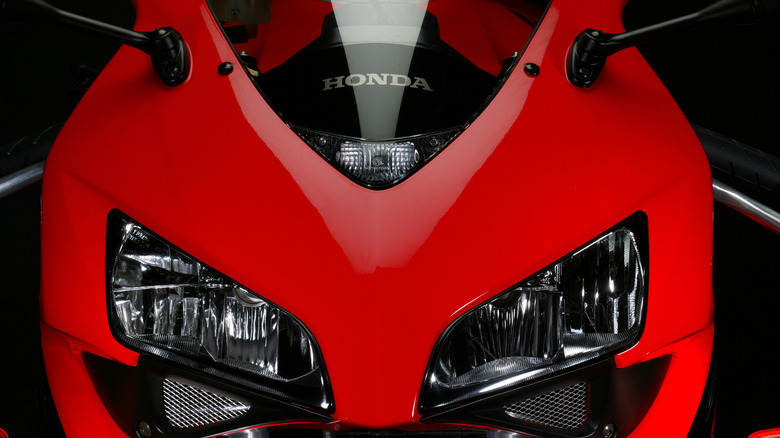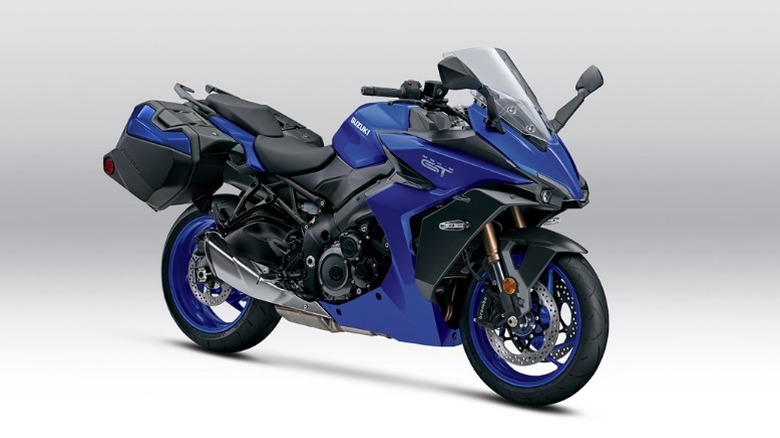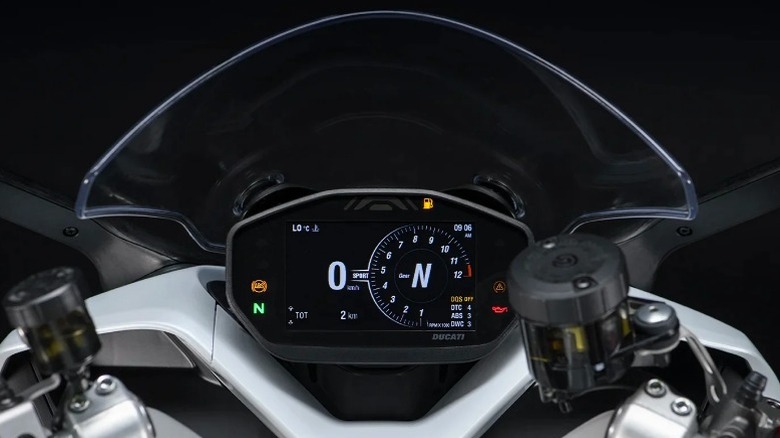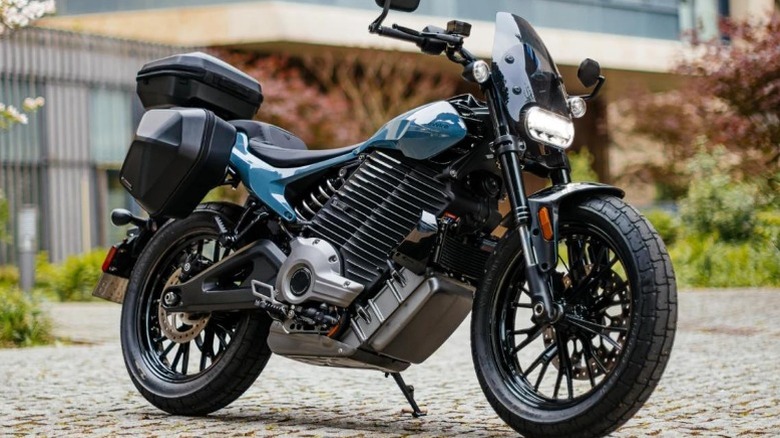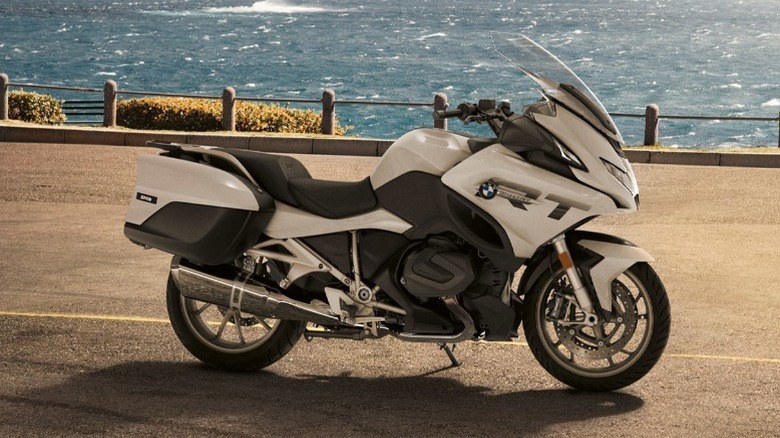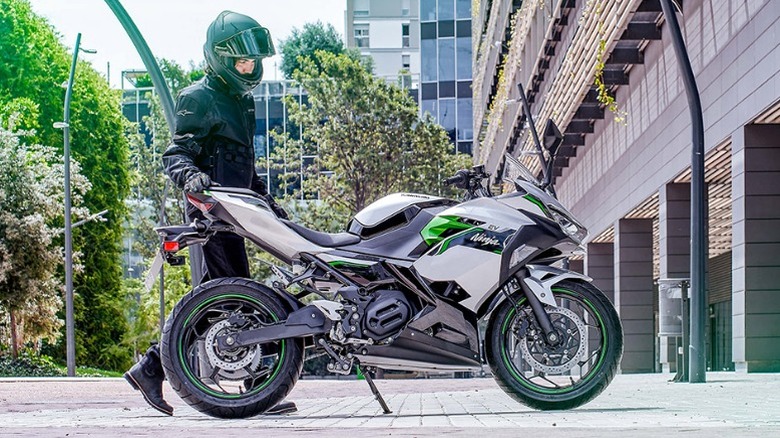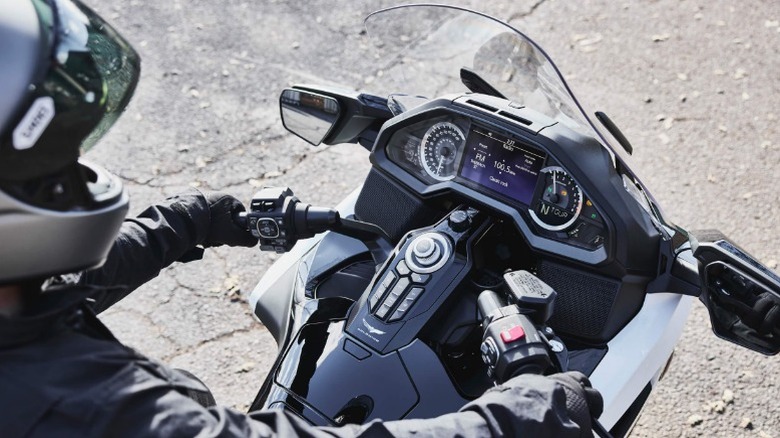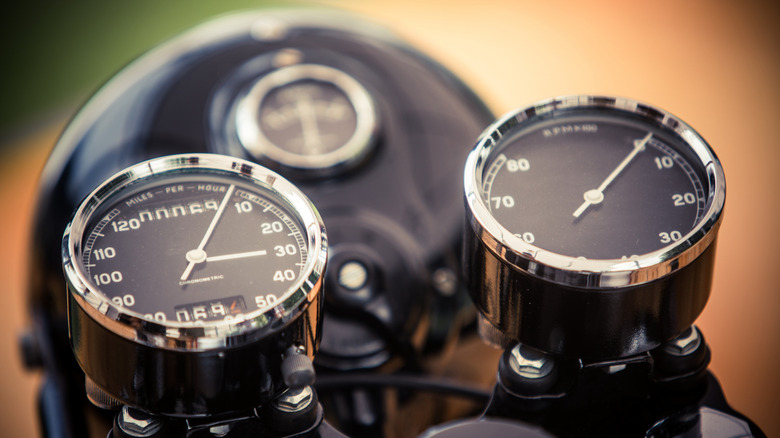6 Motorcycle Brands With The Best Tech
Tech has been edging its way into the motorcycle industry for over a decade now. There was a time not so long ago when the most complicated piece of computerized technology on a bike was its digital display, but that time has passed. There are a few smaller manufacturers out there that might prefer to stick to analog as much as possible, but it seems that the majority of major manufacturers have embraced the added functionality that comes with computer-powered add-ons. You can purchase some great gadgets for motorcycle riders from third parties, but many bikes come stock with these features baked in. GPS navigation, Bluetooth smart device connectivity, and lap tracking can all add to a rider's interface. Meanwhile, internal processing units can control all kinds of things like balance, fuel, acceleration, deceleration, traction, suspension, and more. That's not even touching on the tech that goes into alternative fuel sources. Lithium-ion-powered EVs and hybrid models are becoming more advanced all the time.
I've been riding motorcycles for sixteen years and I've watched as many technological evolutions have made their appearance. Some have been short lived, while others have stood the test of time and gone on to become industry standards, but there are always a few brands who are always on the cutting edge. Those who are thinking about getting a bike and are interested in that sort of thing might be interested in learning which manufacturers have the best and most innovative tech on the market. Some of these companies may excel in different kinds of technological features than others, but all of them are at the forefront of their field.
Suzuki
Suzuki is one of the biggest players when it comes to motorcycle tech. The company has dozens of patented systems in its motorcycles that help to enhance the bikes' rideability and performance. From relatively simple tech like cruise control, all the way to more advanced features such as road adaptive stabilization. There are too many to list, but there are a few that stand out above the rest.
Just one example of a motorcycle in Suzuki's collection that exhibits some of this technological prowess is the GSX-S1000 GT+. This bike has the Suzuki Intelligent Ride System (S.I.R.S.) This is an intricate network of interconnected riding technologies that offers a variety of modes for handling in different terrain and weather conditions. It includes the Suzuki Drive Mode Selector that lets you choose between three different riding modes for performance, the Advanced Traction Control System with five different riding modes for traction, a bi-directional Quick Shift System for clutchless shifting, Easy Start, and Low RPM Assist systems.
Of course, Suzuki also makes dirt bikes, dual sports, street bikes, cruisers, touring bikes, and a plethora of other motorcycle types that benefit from the company's many technical innovations. There are other manufacturers on the market that have similar lists of integrated technologies, but many of them are designed by third-parties and then integrated separately and most of them are designed to operate independently. There are only a handful of brands that offer the level of interconnectivity that comes with Suzuki's first-party, proprietary tech. It's designed to operate as a single, cohesive system.
Ducati
Sometimes referred to as "the Ferrari of motorcycles," you might not be surprised to learn that Ducati is another brand that has some impressive technological innovations in its products. Smaller improvements like the Bi-Function LED modules used the headlights, full TFT color instrumentation, and the Ducati Multimedia System that allows riders to manage calls, music, and navigation via the dash are impressive, but the company's mechanical tech is where it really shines.
Many of these additions can be found in the Ducati Supersport 950. This bike features a Bocsh 6-axis inertial platform that is designed to monitor the vehicle's roll, yaw, and pitch angles as you ride it. Its various control electronics use this spatial monitoring information collection system to interface with its Ducati Traction Control Evo and Ducati Wheelie Control Evo systems, allowing them to respond to the bike's positioning in real-time. Additionally, the motorcycle has Bocsh ABS cornering, Ducat Quick Shift, and three different riding modes: Sport, Touring, and Urban. All of these contribute to more precise handling and power output, making the ride safer.
This kind of thing is interesting to read about on paper, but it has real practical value as well. Ducati's are fast. I've never had the pleasure of riding one myself, but it's no secret that the company's motorcycle's typically have a tremendous amount of torque which gives them a lot of oomph off the starting line. Most of them also have the horsepower to keep the accelleration strong into some pretty high speeds. Technological systems like these can help riders keep the rubber on the road and maintain control of these ridable rockets.
LiveWire (Harley-Davidson)
Few motorcycle brands have as much cultural importance as Harley Davidson. The company is primarily known for making big, strong, loud, American cruisers with deep, gutteral sounding engines. The name Harley Davidson conjures images of heavy steel and classic design, so it might surprise some of you to learn that the company is actually at the forefront of technological innovation on top of its mechanical prowess. You see a lot of this tech in the primary brand, but many of the most exemplary advancements are showcased in Harley's electric sub-brand, LiveWire.
One of the more impressive models that the company has put out in recent years is the S2 Del Mar–an electric street bike with L1 and L2 charging that gets up to 194 ft-lb of torque and can go from 0-60 MPH in just 3 seconds with a top speed of 103 MPH. But as impressive as the basic specifications are, that's just the tip of the iceberg. Like the Ducati, it also has a Bosch 6-axis IMU (internal measurement unit) for spatial monitoring and several different riding modes that regulate throttle mapping, braking, and traction. Additionally, it has a cornering-enhanced anti-lock braking system, a drag-torque slip control system, and a cornering-enhanced traction control system.
I've seen a lot of two wheeled EVs come out over the last decade or so. For all their luster, many of them amount to little more than low-speed scooters that happen to be shaped like a motorcycle. The bikes on display from LiveWire can be counted among the precious few that offer enough performance that they might start to benefit from these kinds of traction and acceleration control modules. Adding in the Bosch IMU is the cherry on top.
BMW
For another of the more technically advanced motorcycle manufacturers, you might consider looking back across the Atlantic. BMW is widely renowned across the automotive world for blending luxury and performance, but its bikes also come with some of the best tech. For instance, "The BMW Motorrad on-board computer provides perfect information management at a glance," the company states. "[It] is programmed for especially fast and comfortable querying of the most important vehicle data. It provides clearly organized information on the info-flat-screen. And it can be operated easily via the "BC button" on the right-hand handlebar."
This includes a range display, speed display, average MPG estimate, oil level indicators, and a temperature display. Some also have a tire pressure monitoring system included. Models with one of the TFT displays can also connect to smart devices and show things like navigation, telephone, and media via the BMW Motorrad Connected app. On top of that, safety features like riding modes, traction control, and ABS are common on many of the company's two-wheeled vehicles.
These kinds of on-board computer enhancements are a boon to any motorcycle type, but the areas where I've seen the most impressive strides from BMW have been in its street and touring bikes. Bikes like the BMW S1000 RR have ABS Pro options, Dynamic Traction Contol, heated grips, cruise control, and Dynamic Dampening Control. Models like the R 1250 RT have adaptive headlights that adjust with the bike's lean angle, hill start control, and stability control. Extra features like these can be a life saver as you start to rack up the miles.
Kawasaki
In the world of Japanese motorcycle manufacturers, Kawasaki is easily one of the more popular options. The brand is primarily known for its ability to balance affordability, reliability, performance, and style. That said, it's also one of the only major sport bike brands to offer both E-bike and hybrid options.
The Ninja e-1 is the company's fully electric model. One thing to note about this bike that sets it apart from many other EVs is that it doesn't look all that different from any other Ninja. Other manufacturers might try to emphasize the empty space where one would usually store a combustion engine, but Kawasaki has kept the overall shape of the fairings the same as the rest of the Ninja line, making the e-1 look more or less like any other sports bike. The tech inside the casing is pretty impressive though. It has two different power modes, an E-Boost that allows riders to get a jolt of extra power when they need it, smartphone connectivity, Walk Mode to help with parking, and ABS.
Then there's the Ninja 7 Hybrid which has a similar design philosophy but with a lot more raw power. Kawasaki describes it as, "a mid-size package with the instant acceleration of a 1,000cc-class supersport model from a standing start (with e-boost), fuel economy on par with smaller displacement models, and button-shift sport riding." Additionally, the bike has three drive modes and a Walk Mode as well. There haven't been many hybrid motorcycles released and even fewer hybrid sport bikes. The Ninja 7 is very appealing to someone like me though, who loves to save at the pump, but is having a hard time giving up the power and acceleration of petrol-powered motorcycles.
Honda
Then, of course, there's Honda. It's no surprise that the best-selling motorcycle manufacturer in the world for over half a century has some of the best tech as well. What's more, you can see examples of the company's exemplary technology in several of the different kinds of motorcycles that the company makes.
The Honda was the first major manufacturer to put an airbag in a motorcycle and the newer models, like the Gold Wing Tour Airbag Automatic DCT, continue to refine the safety feature's functionality and effectiveness. This bike also has a fully automatic 7-speed transmission, multiple riding modes, hill start assist, reverse, ABS, an electrically-controlled windscreen that adjusts the flow of oncoming air, cruise control, heated grips, and a smart key.
On the sports side of things, the Honda CBR1000RR-R Fireblade SP has a direct starter layout that allows the starter to act on the clutch main shaft to keep the engine compact, Selectable Torque Control that allows you to adjust traction at the rear wheel, a quick shifter, and a full-color TFT display with speedometer, tachometer, gear position, fuel level, engine temperature, riding modes, and more. The Honda Africa Twin has an electronically controlled suspension, electronic preload adjustment, cornering ABS, a G switch for offroad riding, Selectable Torque Control, cruise control, and a Blutooth-ready TFT display dash that is compatible with both Apple CarPlay and Android Auto.
I've been a Honda rider since my first bike (an '88 Interceptor I rebuilt when I was 19) and I make no secret of the fact that I'm a fan of the company. Even if Honda's infamous self balancing motorcycle never sees public distribution, I've no doubt that it will continue to remain at the forefront of motorcycle technology for many years to come.
Our methodology
I've been riding motorcycles for over sixteen years and have been writing in the tech space for over half a decade. In making this list, I wanted to showcase brands with some of the most unique and exciting technological enhancements built into their motorcycles, but I also wanted to choose brands that are popular, reliable, and readily available.
There are plenty of concept motorcycles out there that make bold claims about advanced tech, such as self-balancing, auto-piloting, and shape-changing functionality, but these kinds of features are largely unproven and untested in the public sector. Likewise, I didn't want to place focus on bespoke models made by smaller companies that aren't readily available to the public.
In making this list, I looked at several of the most popular motorcycle brands to see what kind of tech they had on offer and relied on my expertise in the space to judge which were most innovative. I then looked at independent reviews of these motorcycles to see if reviewers found these technological enhancements to improve the riding experience in real-world conditions.
